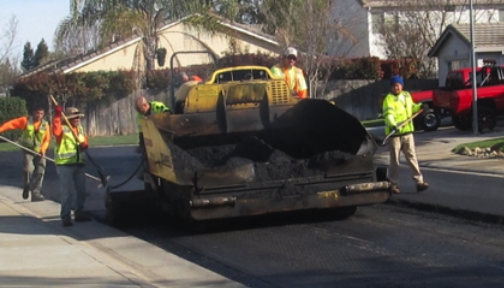Experience the Distinction: Hot Mix Asphalt Paving for Regrading Projects
Wiki Article
Opening the Keys of Warm Mix Asphalt Innovation
Exploring the depths of warm mix asphalt innovation uncovers a globe where meticulous procedures and exact formulations merge to form our roads and infrastructure. The combination of binders, accumulations, and fillers isn't just a building job however a critical orchestration of longevity and performance.Significance of Warm Mix Asphalt
Hot Mix Asphalt plays a vital role in modern-day infrastructure growth due to its toughness and cost-effectiveness. As the most commonly used paving product for roads, freeways, and car park, Hot Mix Asphalt provides an array of benefits that contribute to its relevance in construction tasks. One key advantage is its ability to hold up against rush hour lots and severe climate problems, offering a resilient and reliable surface area for transport networks. Additionally, Hot Mix Asphalt is economical in both first building and long-lasting maintenance, making it a preferred selection for numerous framework tasks.The durability of Warm Mix Asphalt stems from its composition, which consists of aggregates, binder, and filler products that are very carefully selected and blended to satisfy particular efficiency demands. Overall, the significance of Hot Mix Asphalt in facilities development can not be underrated, as it continues to be a keystone of contemporary construction methods.
Components of Asphalt Mixes
The composition of asphalt blends is composed of carefully chosen accumulations, binder, and filler products that are essential for accomplishing details performance requirements. Accumulations are the key part of asphalt mixes, providing stamina and stability. The binder, commonly asphalt or asphalt concrete, holds the aggregates together and provides flexibility and toughness to the mix.The mix and percentage of these parts play a substantial role in determining the quality and performance of the asphalt mix. Engineers carefully make the mix to fulfill details needs, taking into consideration factors like traffic quantity, environment problems, and sidewalk life expectancy. Correct selection and harmonizing of accumulations, binder, and fillers are essential for creating durable, long-lasting asphalt sidewalks.
Combining and Manufacturing Techniques

When the accumulations are chosen, the binder, commonly asphalt concrete, is contributed to bind the products with each other. The binder's top quality and amount substantially influence the mix's toughness, resistance, and adaptability to environmental factors. Additionally, fillers like moisturized lime or Rose city concrete may be integrated to enhance specific characteristics of the asphalt mix, such as its workability or wetness resistance.
During production, the aggregates and binder are warmed, commonly in between 250-325 ° F(121-163 ° C ), to assist in mixing and ensure correct layer of the accumulations. The blending procedure should be extensive to achieve an uniform blend that promotes the desired efficiency attributes of the asphalt. Various strategies, such as set blending or drum mixing, are used to accomplish consistent and top quality asphalt mixes for construction jobs.
Elements Impacting Asphalt Performance
Aspects influencing asphalt efficiency incorporate a range of variables that affect the durability, durability, and total quality of asphalt sidewalks. One essential aspect is the high quality of products used in the asphalt mix.
Environmental problems also influence asphalt efficiency. Temperature variants, moisture seepage, and traffic tons can all impact the structural integrity of the sidewalk. Design factors to consider, such as sidewalk thickness and water drainage, are important in making certain the long-term efficiency of the asphalt hop over to these guys pavement. By thoroughly taking into consideration these service providers, engineers and elements can enhance asphalt efficiency and boost the life span of pavements.
Lasting Practices in Asphalt Modern Technology

Additionally, the growth of warm-mix asphalt (WMA) modern technologies has actually gotten traction in recent times. WMA enables the production and positioning of asphalt blends at lower temperature levels contrasted to standard hot-mix asphalt, leading to reduced power intake and greenhouse gas discharges. The right here use of permeable asphalt blends can help mitigate stormwater runoff issues by enabling water to infiltrate through the sidewalk and into the ground, advertising all-natural water filtration and reenergize processes. By implementing these lasting practices, the asphalt market can contribute to constructing a much more eco-friendly and resilient infrastructure network.
Conclusion
To conclude, warm mix asphalt technology plays a vital role in modern facilities advancement as a result of its resilience and cost-effectiveness. By meticulously stabilizing parts, employing proper mixing methods, and thinking about different aspects, designers can create top notch asphalt blends that hold up against rush hour lots and harsh climate condition. Embracing sustainable techniques, such as making use of recycled products and warm-mix modern technologies, further enhances the ecological kindness of asphalt technology.
Mixing and manufacturing strategies in warm mix asphalt innovation include the accurate combination and processing of aggregates, binder, and fillers to create a high-performance and durable asphalt mix.Factors affecting asphalt efficiency encompass a range of variables that influence the longevity, durability, and general quality of asphalt sidewalks. Sustainable practices in asphalt technology incorporate different initiatives intended at minimizing the environmental influence of asphalt manufacturing and paving processes. By including recovered asphalt pavement (RAP) and recycled asphalt tiles (RAS) into brand-new asphalt mixes, the industry can dramatically minimize the usage of raw materials and power, while also lowering garbage dump waste.
WMA allows for the manufacturing and placement of asphalt mixes at reduced temperatures contrasted to conventional hot-mix asphalt, resulting in reduced power consumption and greenhouse gas discharges.
Report this wiki page